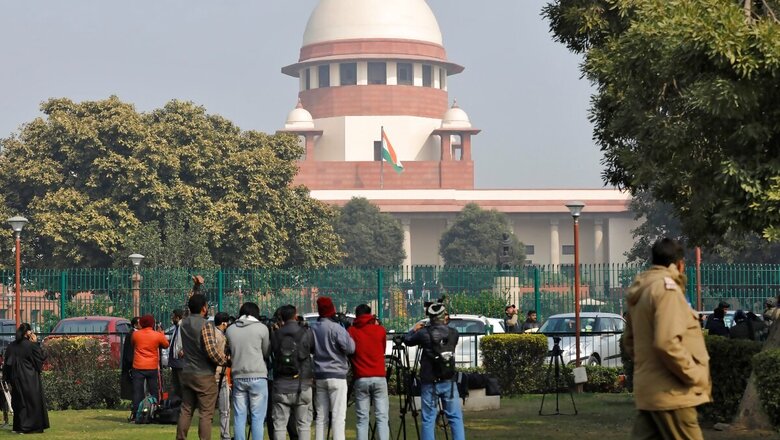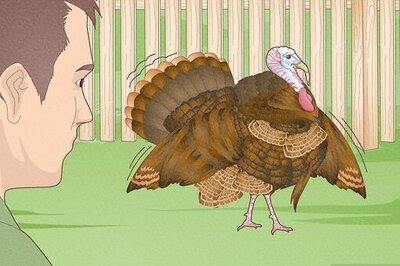
views
Free speech and free press are not mere assurances but the most cherished and basic rights in a society.
A decision to censor them, even by the highest court of land, is fraught with the dangers of a democratic backlash. It may have vile implications in the long run once the safety valve is dismantled, or even tampered with.
On Tuesday, the Supreme Court banned telecast of a TV show. According to the bench of Justices DY Chandrachud, KM Joseph and Indu Malhotra, the object of this show appeared to be vilifying a particular community. Remaining episodes of the TV show were stopped.
Last month, however, the court had refused to ban the telecast, holding it has to be circumspect in imposing a prior restraint on publication or the airing of views.
“Under statutory provisions, competent authorities are vested with powers to ensure compliance with law, including provisions of the criminal law intended to ensure social harmony and the peaceful coexistence of all communities,” the bench then said.
But Tuesday was different. Judges on the bench were not happy about how some TV anchors treat their guests on the shows, mute them, or how they run a “parallel trial”. They talked about revenue and ownership models of TV channels, and the number of advertisements government gives to them.
And soon the debate in the court moved from the idea of free speech and self-regulation to legal restraint, and possibly also a committee to lay down guidelines for the media.
So what happened to the “competent authorities” vested with the powers to ensure compliance with the law that the court cited previously? It is still there.
What about criminal law that can be set into motion in cases of hate speeches and for provoking hatred? It is also very much there. But perhaps, the court now believed they are not enough.
Significantly, there is another case pending before a different bench in the Supreme Court where questions of targeting a particular community by the media during the Covid-19 pandemic had come to fore.
A three-judge bench, headed by the Chief Justice of India, has been categorical that when regulatory and statutory bodies are in place, the petitioners should first approach them. No interim order of restraint against any media organization or otherwise was passed while seeking a definite reply from the petitioners why the apex court should intervene at the first instance.
Also, not too long ago, in 2017, the Supreme Court had delivered a judgment on the need to have a complaint redressal mechanism for TV channels. The three-judge bench, which ruled on the PIL by NGO Common Cause, also had Justice Chandrachud as one of the judges on this bench.
The top court then was satisfied that there were both self-regulatory and governmental mechanisms in place under the Cable Television Networks (Regulation) Act, and the rules framed thereunder. “We are satisfied in concluding that there is indeed an existing mechanism, as has been referred to by the learned Counsel representing the Union of India,” recorded the court.
It asked the Central government to publicise this mechanism so that complainants can be filed before the appropriate forum and to obtain a determination thereof, at the hands of the concerned Competent Authority, in the Ministry of Information and Broadcasting.
This mix of self-regulation and government control is still available. Their lawyers were also present in the court on Tuesday. But the bench was apparently not happy about their functioning – the News Broadcasters Association (NBA) was asked by the judges if it was anything more than a letterhead.
Central government, which had fielded Solicitor General Tushar Mehta, too could not impress upon the bench not to open a Pandora box by issuing an order of censorship. The law officer sought to emphasise the complete fusion of social media that has made the distinction between electronic and print, speech and action, fade when anything can go viral with unpredictable effects and reach.
Issues of restraint on media and censorship in cases of ongoing trials was also adjudicated by a Constitution Bench in 2017. The five-judge Bench said that “guidelines to be framed by the Court, therefore, should be self-regulatory or at the most advisory.”
“Under Article 142, this Court cannot vest courts or any other authority with jurisdiction, adjudicatory or otherwise, which they do not possess… What constitutes an offending publication would depend on the decision of the court on case to case basis. Hence, guidelines on reporting cannot be framed across the board,” said this Bench.
The Constitution Bench also cited judicial decisions in Virendra Vs State of Punjab (1957) and KA Abbas Vs Union of India (1971) to underline that prior restraint on publication is not absolutely prohibited but it has to be done by a statutory authority entrusted with this power, with a right of hearing and appeal to the publisher concerned.
But Tuesday was different. The bench did not wait for the statutory authority to submit whether it has analysed the content of the TV programme. Strangely, the bench too did not do this on its own. Despite a request by the channel’s lawyer to first watch the programme in entirety, the judges went ahead and stopped the telecast by citing a clip.
The dangers lie in the manner in which the censorship order was passed; without waiting for the statutory authority to do its job and without itself watching the full show or even examining what the NBA was proposing to do.
How did the court come to the conclusions of what it did in the end while passing the interim order? Why were the statutory remedies overlooked or bypassed? Will the court now substitute itself for the authorities under the Cable TV Act and the Rules to examine the complaints at the first instance in all cases in future? Was the self-regulatory body even asked what it proposed to do?
The idea of censorship is a double-edged sword. With the reach of social media, the conventional ideas about censorship also need to change because things eventually get disseminated one way or the other.
Censorship will always invite charges of partisanship more than it will cleanse the system of hateful speech. An immediate legal intervention and a pre-broadcast censorship will not leave a state safer for liberty in the long run. For, it would promote the idea of censorship and create a precedent, giving subjective liberty to judges in future. Court cases can become a tool to harass and stop publications and telecast. Role reversal is inevitable between complainants and supporters.
But for a very high standard and an extremely cautious approach, the legal intervention will give the pretext to the warring groups to assert their powers, and put unprecedented limits on free speech.
Not everything published or telecast by the media is appropriate; some are even in contravention of the laws. But when there is a system in place, acknowledged by the top court in several of its judgments, why it should be ignored even in one case. An exception once can become a precedent. It can then be used in several other cases — the safety valve is gone. Courts, by becoming an arbiter of taste, will only drag itself into a web.
In the process of upholding free speech, no doubt some obnoxious things will also pass through. But the idea of free speech will only get strengthened for all times to come. The safety valve will exist for you, and for me


















Comments
0 comment